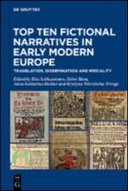Explore

Top Ten Fictional Narratives in Early Modern Europe
0 Ungluers have
Faved this Work
Login to Fave
This volume examines the ten most popular fictional narratives in early modern Europe between 1470 and 1800. Each of these narratives was marketed in numerous European languages and circulated throughout several centuries. Combining literary studies and book history, this work offers for the first time a transnational perspective on a selected text corpus of this genre. It explores the spatio-temporal transmission of the texts in different languages and the materiality of the editions: the narratives were bought, sold, read, translated and adapted across European borders, from the south of Spain to Iceland and from Great Britain to Poland. Thus, the study analyses the multi-faceted processes of cultural circulation, translation and adaptation of the texts. In their diverse forms of mediality such as romance, drama, ballad and penny prints, they also make a significant contribution to a European identity in the early modern period. The narrative texts examined here include Apollonius, Septem sapientum, Amadis de Gaula, Fortunatus, Pierre de Provence et la belle Maguelonne, Melusine, Griseldis, Aesopus’ Life and Fables, Reynaert de vos and Till Ulenspiegel. ; This volume examines the ten most popular fictional narratives in early modern Europe between 1470 and 1800. Each of these narratives was marketed in numerous European languages and circulated throughout several centuries. Combining literary studies and book history, this work offers for the first time a transnational perspective on a selected text corpus of this genre. It explores the spatio-temporal transmission of the texts in different languages and the materiality of the editions: the narratives were bought, sold, read, translated and adapted across European borders, from the south of Spain to Iceland and from Great Britain to Poland. Thus, the study analyses the multi-faceted processes of cultural circulation, translation and adaptation of the texts. In their diverse forms of mediality such as romance, drama, ballad and penny prints, they also make a significant contribution to a European identity in the early modern period. The narrative texts examined here include Apollonius, Septem sapientum, Amadis de Gaula, Fortunatus, Pierre de Provence et la belle Maguelonne, Melusine, Griseldis, Aesopus’ Life and Fables, Reynaert de vos and Till Ulenspiegel.
This book is included in DOAB.
Why read this book? Have your say.
You must be logged in to comment.
Rights Information
Are you the author or publisher of this work? If so, you can claim it as yours by registering as an Unglue.it rights holder.Downloads
This work has been downloaded 55 times via unglue.it ebook links.
- 55 - pdf (CC BY-NC-ND) at Unglue.it.
Keywords
- book history
- Early modern literature
- European literary identity.
- Literary studies: general
- Literature & literary studies
- Literature: history & criticism
- Mediality
- Printing
- thema EDItEUR::D Biography, Literature and Literary studies::D Biography, Literature and Literary studies::DS Literature: history and criticism
- thema EDItEUR::D Biography, Literature and Literary studies::DS Literature: history and criticism::DSB Literary studies: general
- Translation
- transmission of narratives
Links
DOI: 10.1515/9783110764451Editions

